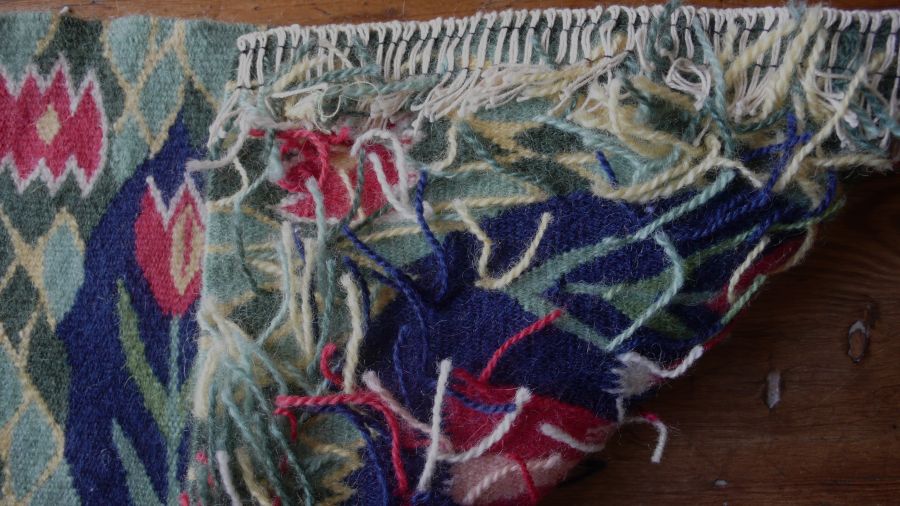ikfoundation.org
The IK Foundation
Promoting Natural & Cultural History
Since 1988


HISTORICAL REPRODUCTIONS
– 18th & 19th Century Dove-tail Tapestry
The dove-tail tapestry technique is known in Swedish as flamskväv or ‘Flemish weave’. Similar tapestry weaving can be seen on textiles that are thousands of years old, from many different parts of the world: for instance, as decorations on clothing and later as wall decorations. Such a technique opens up great possibilities for the use of free patterns, and it has mainly been used in the representation of scenes with figures, including people, animals and landscapes, but also simple scattered flowers and leaves, all with immense richness in details and nuances. The attempt to reproduce part of a cushion in this technique originates in a pattern-combination seen on a couple of preserved square-shaped fabrics made in upright looms around 1800 to 1830 in the Torna district in southernmost Sweden.
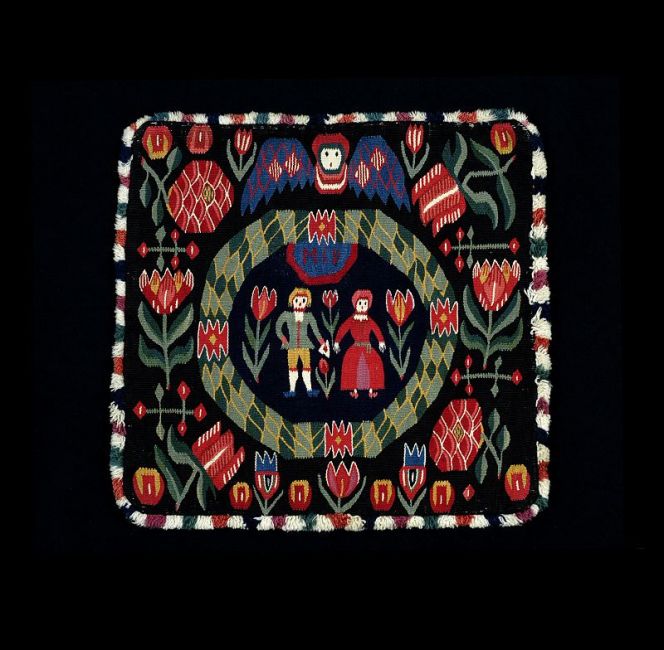 The centre part of this beautiful flamskväv cushion (50x50cm) was the original source and inspiration for this reproduction. This original tapestry is also unusually well-preserved in colour as well as its linen warp, woollen weft, back of woollen twill and fringe. It was woven in southernmost Sweden; Torna district, Skåne. (Courtesy of: Kulturen in Lund, KM 24616, Creative Commons).
The centre part of this beautiful flamskväv cushion (50x50cm) was the original source and inspiration for this reproduction. This original tapestry is also unusually well-preserved in colour as well as its linen warp, woollen weft, back of woollen twill and fringe. It was woven in southernmost Sweden; Torna district, Skåne. (Courtesy of: Kulturen in Lund, KM 24616, Creative Commons).Some further research into the history of this particular flamskväv cushion reveals that the textile was sold, jointly with about twenty other 18th and 19th century textiles, by Sven Bengtsson to the museum Kulturen in 1916. Additionally, in the same year, an almost identical example – together with more than two thousand other textile treasures – was included in the comprehensive publication Gammal Allmogeslöjd från Malmöhuslän. The only visible difference between the two textiles is the bride-to-be’s initials in the marking, so the two cushions were probably woven if not in the same family, at least in the same village or close district.
This folio-sized publication was based on a large-scale inventory of traditional textiles in southernmost Sweden. A translation of the quote for this particular cushion gives a good understanding of the enormous work which was done by the area’s handicraft organisation one hundred years ago. Their aim with this publication was to spread knowledge about the area's former textiles via careful factual research and colour or black & white photographs of each item, but also to secure as much oral information as possible from the relatives still having the knowledge of where and by whom these various textiles were once made.
See the image below and quote in translation from the Swedish, as an example of this detailed inventory (Malmöhusläns …1916. p. 111): ‘On this square shaped cushion, the “Annunciation” pattern has been changed to another image, while the green wreath and it there above floating blue angle and all its surrounding flowers have been kept. The small couple, which besides the three tulips are centred in the wreath, alternatively named the “bridal couple”, “betrothal”, or “twins”. Most likely, it is probable that it depicts a young couple celebrating their betrothal or wedding, and it may have been woven into just such an occasion. The girl is dressed in a red wedding dress, and on her head, she wears the red girl-ribbon, which at this stage is not a white bonnet, the married woman’s characteristic. The man is dressed in the typical dress from Torna district, where the clogs have been woven blue instead of black and the coat greying green instead of blue or white. The cushion is marked BID, edged with a multi-coloured woollen fringe. Size 52×52 cm. Owner [1916]: Ingrid Persson, Weberöd parish, Torna district. She inherited it from her mother, Anna Kristenssdotter, Hasslemölla, Weberöd parish, Torna district. If she or her mother has woven it, there is no knowledge.’
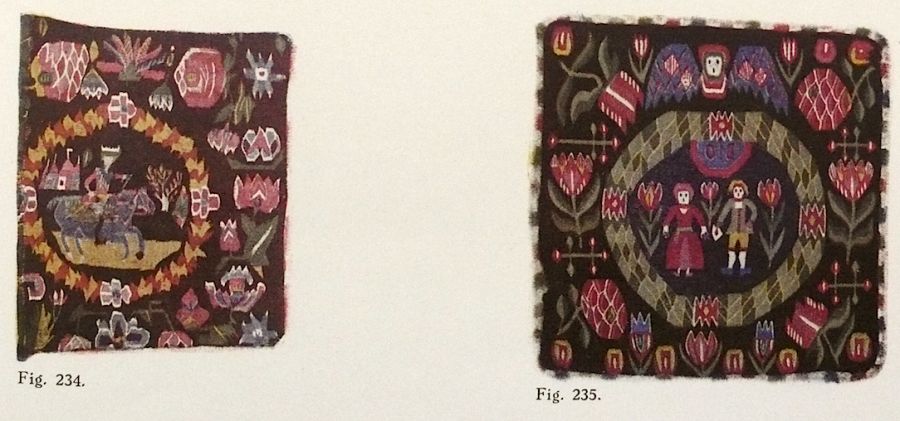 Here the almost identical flamskväv cushion, included together with other designs from the Torna district in the inventory, included in the publication of textiles in 1916 (Gammal Allmogeslöjd… Plate: 235).
Here the almost identical flamskväv cushion, included together with other designs from the Torna district in the inventory, included in the publication of textiles in 1916 (Gammal Allmogeslöjd… Plate: 235).In the making of dove-tail tapestries, the design, in the form of a sketch, is placed behind the warp threads. The tapestry is woven on its side so that, when complete, the linen warp (covered by the woollen weft) runs horizontally. The weft follows the rounded forms found in the various designs, and dove-tailing is used to join two areas of colour, where there would otherwise be a slit. As with all tapestry weaving, the technique is relatively slow, while no shuttle is in use. For the reproduction, the warp was a 4-ply strong linen thread and weft in 2-ply woollen yarn, specially dyed and spun to be used for reproductions of these dove-tail tapestries or parts of the same. The yarn was spun and dyed by Wålstedts in Dalarna (Sweden) and purchased in the 1980s via, at the time, an active Handicraft Organisation in Malmö to be as close as possible to the original tapestries in quality as well as colour (even if the original colours are somewhat darker). The chosen colours were synthetically dyed, but an even more favourable experiment had been to use natural dyes to come even closer to the original seven shades. For example, by using the following plants/insects:
- Madder (Rubia tinctorum) – red
- Cochineal (Dactylopius coccus) – reddish pink
- Indigo (Indigofera tinctoria) – dark & light blue
- Birch leaves (Betula alba) – yellow
- Birch leaves & Indigo – dark & light green
- Added with: Natural white wool – white
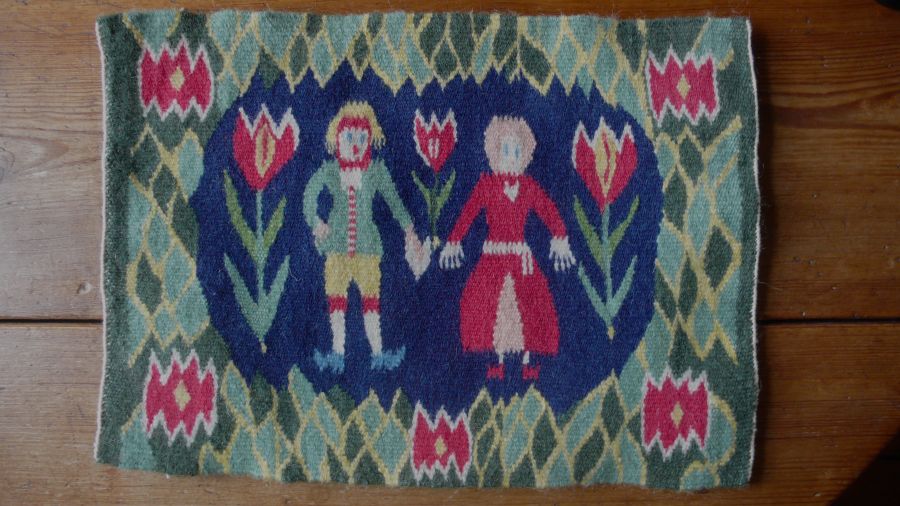 Historical reproduction of flamskväv or dove-tail tapestry (wool and linen, 32x22cm). Photo and woven fabric: Viveka Hansen.
Historical reproduction of flamskväv or dove-tail tapestry (wool and linen, 32x22cm). Photo and woven fabric: Viveka Hansen.Most of the extant dove-tail tapestries (flamskväv) originate from rural society. The weavers frequently dated and signed their works, and these inscriptions suggest that the surviving textiles were woven mainly between 1750 and 1850. The earliest mention of a dove-tail tapestry in a farmer’s home can be found in an estate inventory of 1742, at the death of Ingeborg Persdotter’s husband – though, of course, we do not know if the tapestry was new at this time. In all events, the number of dove-tail tapestries in estate inventories increased during the following decades and reached its peak at the end of the eighteenth century. This accords well with the dates interwoven or embroidered on the surviving cushions and covers. The textile researcher Ernst Fisher also emphasised that the art of dove-tail tapestry weaving became established in certain families and was practised for several generations.
The spread of the technique seems to have been surprisingly limited, confined to the southwest of Skåne and centred on the districts of Torna and Bara, in the vicinity of Lund and on the districts south of Malmö, namely Oxie, Skytts and Vemmenhög. Judging from the patterns used, these two areas developed a tapestry tradition independent of each other, and we assume that earlier workshops of the two towns of Lund and Malmö spread the art to their own vicinity. However, we cannot say with certainty why the dove-tail tapestry technique was common only in these two areas. One probable reason is that this type of weaving was very time-consuming, thus limiting it to prosperous farmer’s areas where people had the time for such an occupation.
![For smaller sample weaving a frame can be used, but otherwise the upright loom was the traditional model for this type of weaving. This depicted loom with its “ongoing weaving” is marked ‘Ao 1830’ ‘BOD’ and was purchased for the Nordic Museum by the folklore researcher Nils Månsson Mandelgren in 1874 for 20 Swedish Kronor [Crowns]. As the date on the loom suggests, it was by its original owner in use from 1830 and possibly not for more than two or three decades – in Blentarp parish, Torna district, Skåne, Sweden. (Courtesy of: Nordic Museum, Stockholm, NM.0004785, & historical facts from catalogue card. Creative Commons).](https://www.ikfoundation.org/uploads/image/5-flamsk-664x842.jpg) For smaller sample weaving a frame can be used, but otherwise the upright loom was the traditional model for this type of weaving. This depicted loom with its “ongoing weaving” is marked ‘Ao 1830’ ‘BOD’ and was purchased for the Nordic Museum by the folklore researcher Nils Månsson Mandelgren in 1874 for 20 Swedish Kronor [Crowns]. As the date on the loom suggests, it was by its original owner in use from 1830 and possibly not for more than two or three decades – in Blentarp parish, Torna district, Skåne, Sweden. (Courtesy of: Nordic Museum, Stockholm, NM.0004785, & historical facts from catalogue card. Creative Commons).
For smaller sample weaving a frame can be used, but otherwise the upright loom was the traditional model for this type of weaving. This depicted loom with its “ongoing weaving” is marked ‘Ao 1830’ ‘BOD’ and was purchased for the Nordic Museum by the folklore researcher Nils Månsson Mandelgren in 1874 for 20 Swedish Kronor [Crowns]. As the date on the loom suggests, it was by its original owner in use from 1830 and possibly not for more than two or three decades – in Blentarp parish, Torna district, Skåne, Sweden. (Courtesy of: Nordic Museum, Stockholm, NM.0004785, & historical facts from catalogue card. Creative Commons).In the second half of the 19th century – when the long tradition of weaving such textiles almost completely had ceased – it was not unusual to cut up, re-shape and use these fabrics for other purposes in all sorts of situations. These two chairs (below) from a bourgeois home in Stockholm are one such good example of how to place the originally wealthy farmers' cushions, bedcovers, etc, in a totally new context in the late 19th century or early 20th. These are still well-preserved, even if they have lost some of their history – but unfortunately, many other textiles were not cared for in the same way and, in the worst cases, used as door mats or horse blankets.
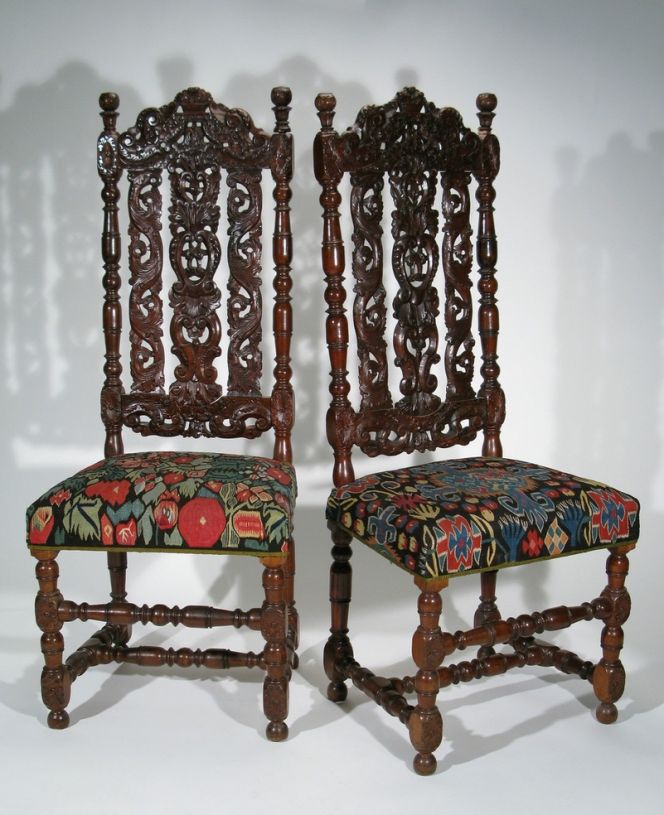 These two baroque style chairs of walnut tree is upholstered with pieces of flamskväv from southwest Skåne, woven in the late 18th or early 19th century. The colourful fabrics were originally used as either cushions, bench- or bedcovers primarily woven for the young woman’s dowry and only used for special occasions. Most of the year the textile treasures were stored in chests, which kept the colours unfaded and preserved for generations. The long-term careful handling of the textiles, became very useful when finding new uses in the late 19th century, for example to fit the seats of these two chairs. Gift to the Nordic Museum in 1919. (Courtesy of: Nordic Museum, Stockholm, NM.0135172A+B, & historical facts from catalogue card. Creative Commons).
These two baroque style chairs of walnut tree is upholstered with pieces of flamskväv from southwest Skåne, woven in the late 18th or early 19th century. The colourful fabrics were originally used as either cushions, bench- or bedcovers primarily woven for the young woman’s dowry and only used for special occasions. Most of the year the textile treasures were stored in chests, which kept the colours unfaded and preserved for generations. The long-term careful handling of the textiles, became very useful when finding new uses in the late 19th century, for example to fit the seats of these two chairs. Gift to the Nordic Museum in 1919. (Courtesy of: Nordic Museum, Stockholm, NM.0135172A+B, & historical facts from catalogue card. Creative Commons).However, many Swedish museums have extensive collections of these dove-tail tapestries from southernmost Sweden. Primarily due to the early curators of these institutions who searched for and saved textiles for future generations without changing their sizes and original purposes in any way. These items were collected/bought/received as gifts from the 1880s and a couple of decades into the new century, during a period when these once treasured textiles had long lost importance for families and the young women’s dowry in various wealthy farmers areas.
Sources:
- DigitaltMuseum (Upright loom and several examples of ‘Flamskväv’ from Skåne in southernmost Sweden).
- Fischer, Ernst, Flamskvävnader i Skåne, Lund 1962.
- Hansen, Viveka, Swedish Textile Art, London 1996.
- Hansen, Viveka (Historical reproduction/weaving of flamskväv).
- Kulturen in Lund (Digital source: flamskväv & historical facts from catalogue card).
- Malmöhusläns Hemslöjd, Gammal Allmogeslöjd från Malmöhuslän, Malmö 1916.
- The former Handicraft Organisation in Malmö (Woollen yarn and linen thread for the woven reproduction).
Essays
The iTEXTILIS is a division of The IK Workshop Society – a global and unique forum for all those interested in Natural & Cultural History from a textile Perspective.
Open Access essays, licensed under Creative Commons and freely accessible, by Textile historian Viveka Hansen, aim to integrate her current research, printed monographs, and earlier projects dating back to the late 1980s. Some essays feature rare archive material originally published in other languages, now available in English for the first time, revealing aspects of history that were previously little known outside northern European countries. Her work also explores various topics, including the textile trade, material culture, cloth manufacturing, fashion, natural dyeing, and the intriguing world of early travelling naturalists – such as the "Linnaean network" – viewed through a global historical lens.
For regular updates and to fully utilise iTEXTILIS' features, we recommend subscribing to our newsletter, iMESSENGER.
been copied to your clipboard




– a truly European organisation since 1988
Legal issues | Forget me | and much more...
You are welcome to use the information and knowledge from
The IK Workshop Society, as long as you follow a few simple rules.
LEARN MORE & I AGREE


